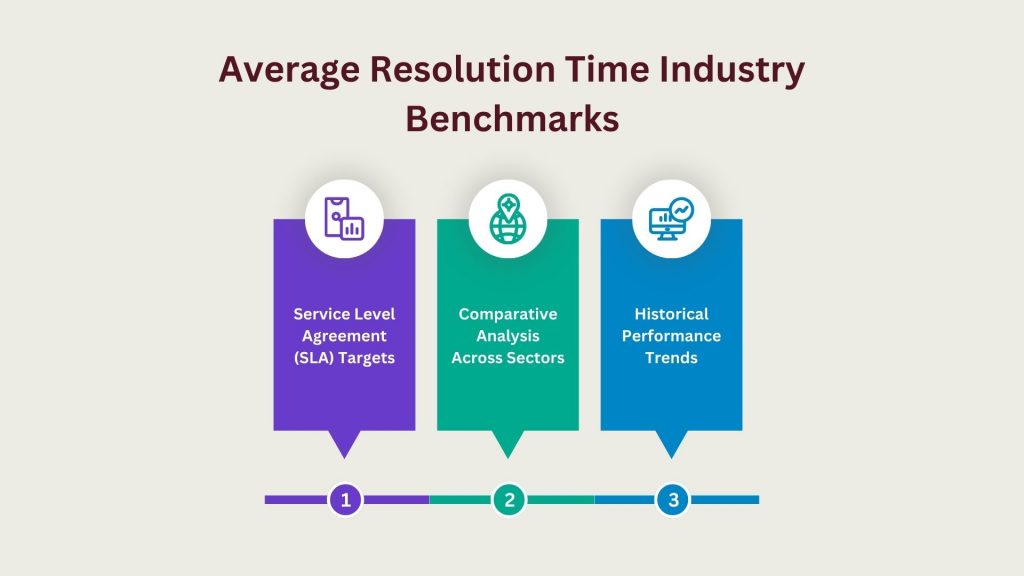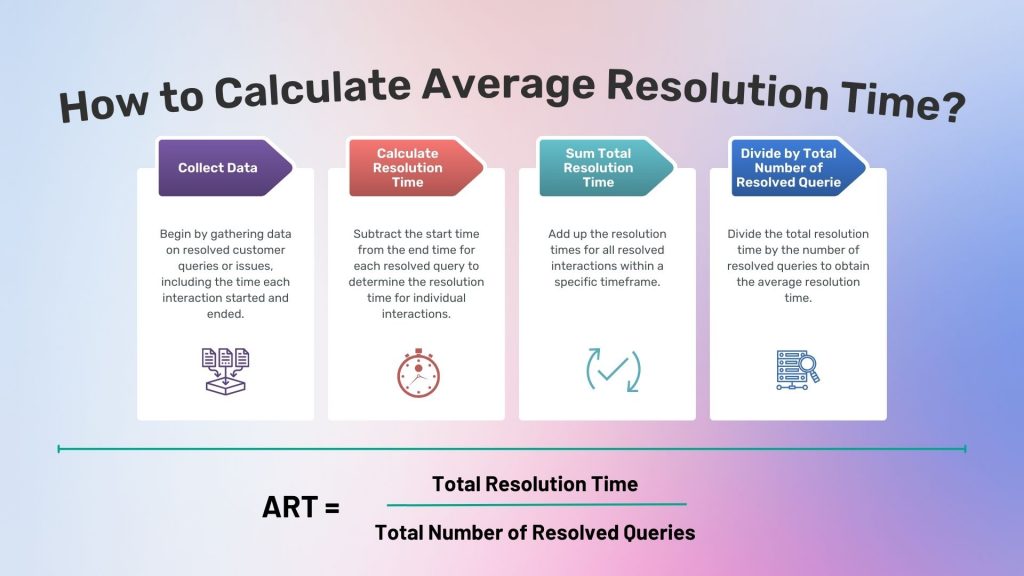“Time is of the essence.” This timeless adage resonates deeply within the realm of call centers, where every second counts towards customer satisfaction and operational efficiency. Efficiency isn’t just a buzzword; it’s a necessity. With consumers expecting swift resolutions, mastering Average Resolution Time is crucial for maintaining loyalty and brand reputation.
In today’s hyper-connected world, consumers demand swift and effective solutions to their queries and concerns. According to recent studies, over 70% of customers expect their issues to be resolved within 5 minutes. Failure to meet these expectations can result in diminished customer loyalty and tarnished brand reputation.
What Does Average Resolution Time (ART) Mean?
At its core, Average Resolution Time (ART) represents the average duration required to address customer inquiries or resolve issues within a call center environment. It serves as a key performance indicator (KPI) in evaluating the efficiency and effectiveness of customer service operations.
Measured from the moment a customer initiates contact until their query is satisfactorily resolved, ART encompasses various communication channels, including phone calls, emails, chats, and social media interactions. This metric provides valuable insights into the responsiveness and proficiency of call center agents in delivering solutions promptly.
Average Resolution Time (ART) vs Average Handle Time (AHT)
While Average Resolution Time (ART) focuses specifically on the time taken to resolve customer issues, Average Handle Time (AHT) encompasses the entire duration of customer interaction, including hold times and post-resolution tasks. While both metrics are vital in call center management, ART provides a more targeted insight into the resolution process’s efficiency.
How Can Average Resolution Time (ART) Help the Call Center?
Embracing ART as a cornerstone metric offers multifaceted benefits to call centers striving for excellence. Firstly, tracking ART enables organizations to gauge their performance accurately and identify areas for improvement. By setting realistic targets based on ART benchmarks, call centers can enhance their operational efficiency and meet customer expectations consistently.
Moreover, ART plays a pivotal role in driving customer satisfaction and loyalty. Research indicates that 86% of consumers are willing to pay more for better customer experience, highlighting the paramount importance of swift issue resolution. By minimizing ART, call centers can foster positive customer interactions, nurture brand advocacy, and ultimately drive revenue growth.
Furthermore, ART catalyzes operational optimization within call centers. By analyzing ART trends and patterns, organizations can streamline workflows, allocate resources effectively, and implement targeted training programs to empower agents with the necessary skills and knowledge to excel in their roles.
Importance of ART in Customer Service Management
ART serves as a barometer of customer service effectiveness, directly influencing customer satisfaction levels. In today’s hyper-connected world, where customers demand instant gratification, ART holds the key to retaining and delighting clientele. It’s not just about resolving issues swiftly; it’s about doing so with precision and empathy.
Role of ART in Improving Operational Efficiency
Efficient resolution processes aren’t just beneficial for customers; they’re also advantageous for call center operations. By reducing resolution times, call centers can handle a higher volume of inquiries, optimize resource allocation, and ultimately, improve overall operational efficiency.
Factors to Consider in ART Calculation
While the methodology for ART calculation remains consistent, it’s imperative to consider various factors that may influence the accuracy and interpretation of this metric:
- Nature of Queries: Complex issues may inherently require longer resolution times compared to routine inquiries. Differentiate between query types to gain insights into ART trends and patterns.
- Communication Channels: ART may vary significantly across different communication channels, such as phone calls, emails, chats, and social media interactions. Factor in these channel-specific nuances to derive actionable insights and optimize performance accordingly.
- Service Level Agreements (SLAs): Align ART calculations with predefined SLAs to ensure adherence to performance targets and contractual obligations. Strive to surpass SLA benchmarks to foster trust and credibility with customers.
Average Resolution Time Industry Benchmarks
Navigating the labyrinth of call center management requires a keen understanding of industry benchmarks and best practices. Here’s an overview of industry-standard ART benchmarks and their significance:

Benchmark 1: Service Level Agreement (SLA) Targets
SLA agreements typically stipulate target ART thresholds that call centers must meet to uphold service excellence and customer satisfaction. By aligning ART benchmarks with SLA targets, organizations can proactively identify areas for improvement and strive for continuous enhancement.
Benchmark 2: Comparative Analysis Across Sectors
Comparing ART benchmarks across sectors offers valuable insights into industry trends, competitive landscapes, and opportunities for optimization. Benchmarking against peer organizations enables call centers to gauge their performance relative to industry norms and establish realistic performance goals.
Benchmark 3: Historical Performance Trends
Analyzing historical ART data allows call centers to track performance trends over time, identify seasonality patterns, and anticipate fluctuations in customer demand. By leveraging historical insights, organizations can implement proactive measures to mitigate potential bottlenecks and optimize resource allocation.
Importance of Benchmarking in Setting Performance Goals
Benchmarking serves as a compass guiding call centers towards operational excellence and customer-centricity. By benchmarking ART against industry standards, organizations can:
- Identify Performance Discrepancies: Highlight disparities between current performance levels and industry benchmarks, prompting targeted interventions to bridge the gap.
- Drive Continuous Improvement: Foster a culture of continuous improvement by setting ambitious yet achievable performance goals based on industry benchmarks and best practices.
- Enhance Competitiveness: Gain a competitive edge by surpassing industry benchmarks, exceeding customer expectations, and solidifying market leadership in the fiercely competitive landscape of customer service management.
How to Calculate Average Resolution Time?
In the intricate tapestry of call center operations, mastering the art of calculating Average Resolution Time (ART) is paramount to driving efficiency and delivering exceptional customer service. Let’s embark on a step-by-step journey to unravel the intricacies of ART calculation:
Step-by-Step Guide to Calculating ART:
- Collect Data: Begin by gathering data on resolved customer queries or issues, including the time each interaction started and ended.
- Calculate Resolution Time: Subtract the start time from the end time for each resolved query to determine the resolution time for individual interactions.
- Sum Total Resolution Time: Add up the resolution times for all resolved interactions within a specific timeframe.
- Divide by Total Number of Resolved Queries: Divide the total resolution time by the number of resolved queries to obtain the average resolution time.

Factors to Consider in ART Calculation:
- Time Frame: The timeframe over which ART is calculated can significantly influence the metric’s accuracy. Shorter timeframes may provide more granular insights, while longer periods offer a broader perspective.
- Inclusion Criteria: Determine which interactions are included in the calculation. For instance, should only successfully resolved queries be considered, or should abandoned calls and unresolved issues also be factored in?
- Exclusion Criteria: Identify any outliers or anomalies that may skew the results, such as exceptionally long or short resolution times.
Average Resolution Time Industry Benchmarks
Overview of Industry-Standard ART Benchmarks
Industry benchmarks serve as invaluable reference points for call centers striving for excellence in customer service. While benchmarks may vary across sectors and regions, they provide valuable insights into industry norms and best practices.
Comparison of ART Benchmarks Across Different Sectors
Various industries may have different expectations when it comes to ART. For instance, industries with complex products or services may tolerate longer resolution times compared to sectors where quick issue resolution is paramount.
Importance of Benchmarking in Setting Performance Goals
Benchmarking allows call centers to assess their performance relative to industry standards and identify areas for improvement. By setting realistic goals based on industry benchmarks, organizations can align their efforts with best practices and drive continuous improvement.
Ideal Average Resolution Times by Channel
In the dynamic landscape of call center operations, communication channels vary in their nuances, presenting unique challenges and opportunities for resolution. Understanding the ideal Average Resolution Time (ART) benchmarks across different channels is essential for optimizing customer service efficiency and satisfaction.
Examination of ART Benchmarks for Different Communication Channels
- Phone Calls: Phone calls remain a staple in customer communication, offering real-time interaction and personalized assistance. However, they often entail longer resolution times due to the inherent complexities of verbal communication. Ideal ART for phone calls typically ranges between 4 to 6 minutes, depending on the nature of the query and agent proficiency.
- Email Correspondence: Email serves as a convenient communication channel for customers seeking detailed explanations or documentation. However, its asynchronous nature can result in extended resolution times. The ideal ART for email correspondence typically falls within the range of 12 to 24 hours, balancing thoroughness with timeliness.
- Live Chat Support: Live chat offers the immediacy of phone calls with the convenience of text-based communication. Its real-time nature enables quick query resolution, with ideal ART ranging from 2 to 4 minutes. By leveraging pre-written responses, chatbots, and efficient agent training, call centers can achieve swift resolutions via live chat.
- Social Media Platforms: Social media platforms have emerged as prominent customer service channels, offering direct engagement and public visibility. However, the dynamic nature of social media demands prompt responses to maintain brand reputation. The ideal ART for social media interactions typically hovers around 15 to 30 minutes, striking a balance between responsiveness and resolution quality.
Factors Influencing ART Variation by Channel
- Nature of Communication: The intricacies of verbal communication in phone calls may result in longer resolution times compared to text-based channels like email and live chat. Understanding the nuances of each channel allows call centers to tailor their strategies accordingly.
- Customer Expectations: Customer expectations vary across communication channels, influencing their tolerance for resolution times. While social media users may expect rapid responses, email correspondents may prioritize thoroughness over immediacy.
- Agent Skillset and Training: Agent proficiency plays a crucial role in determining ART across channels. Well-trained agents equipped with effective communication skills and problem-solving abilities can expedite resolution processes irrespective of the communication medium.
Strategies for Optimizing ART Across Various Communication Channels
- Channel-Specific Training: Provide agents with specialized training tailored to the unique demands of each communication channel. Equip them with best practices, response templates, and escalation protocols to streamline resolution processes.
- Technology Integration: Leverage technology solutions such as automated response systems, chatbots, and CRM integrations to enhance efficiency across communication channels. Automation can significantly reduce response and resolution times, ensuring timely customer assistance.
- Performance Monitoring and Feedback: Implement robust monitoring systems to track ART metrics across different channels in real-time. Provide agents with constructive feedback and performance incentives to incentivize adherence to ART benchmarks.
By understanding the ideal ART benchmarks and implementing channel-specific optimization strategies, call centers can deliver exceptional customer service experiences across all communication channels, fostering loyalty and satisfaction.
How to Reduce Resolution Time in Call Centers?
Efficiency is the cornerstone of successful call center operations, and reducing resolution time is paramount in achieving optimal performance. By implementing strategic initiatives and leveraging technology, call centers can streamline processes, enhance customer satisfaction, and elevate overall performance.
Techniques for Improving Efficiency and Reducing ART
- Streamlined Processes: Simplify and standardize resolution processes to minimize unnecessary steps and reduce resolution time. Clear escalation paths, standardized response templates, and streamlined workflows empower agents to address customer queries efficiently.
- Agent Empowerment: Empower agents with the authority and resources needed to resolve customer issues independently. Encourage autonomy, critical thinking, and decision-making skills to expedite issue resolution and minimize escalations.
- Effective Training Programs: Invest in comprehensive training programs that equip agents with the skills and knowledge required to handle diverse customer queries efficiently. Focus on communication skills, product knowledge, and problem-solving techniques to enhance agent effectiveness.
- Performance Incentives: Implement performance-based incentives tied to resolution time targets to motivate agents and foster a culture of efficiency. Reward agents who consistently meet or exceed ART benchmarks, encouraging proactive problem-solving and timely issue resolution.
Utilization of Technology and Tools to Streamline Processes
- Automation Solutions: Leverage automation solutions such as chatbots, IVR systems, and self-service portals to automate routine tasks and reduce agent workload. Automation not only accelerates response times but also enhances accuracy and consistency in issue resolution.
- Integrated CRM Systems: Integrate Customer Relationship Management (CRM) systems with call center platforms to provide agents with comprehensive customer insights and historical interaction data. Equipped with relevant information, agents can expedite issue resolution and deliver personalized service.
- Predictive Analytics: Harness the power of predictive analytics to anticipate customer needs and proactively address potential issues. By analyzing historical data and customer patterns, call centers can preemptively resolve issues, minimizing resolution time and enhancing customer satisfaction.
- Real-time Monitoring and Analytics: Implement real-time monitoring and analytics tools to track key performance metrics, including ART, queue times, and customer satisfaction scores. Identify bottlenecks and inefficiencies in real-time, allowing for prompt intervention and resolution.
By adopting a multifaceted approach that combines process optimization, agent empowerment, and technology integration, call centers can effectively reduce resolution time, enhance operational efficiency, and elevate customer satisfaction levels.
Future of Average Resolution Time in Call Centers
As call center dynamics continue to evolve in response to technological advancements and shifting customer expectations, the landscape of Average Resolution Time (ART) measurement and optimization is poised for transformation. Let’s explore the emerging trends shaping the future of call center management and conclude our comprehensive guide with key takeaways.
Emerging Trends in Call Center Management Related to ART
- Integration of Artificial Intelligence (AI): AI-powered solutions, such as natural language processing (NLP) and machine learning algorithms, are revolutionizing call center operations. These technologies enable predictive analytics, sentiment analysis, and automated issue resolution, leading to faster response times and enhanced customer experiences.
- Omni-channel Support: With customers increasingly utilizing multiple communication channels, call centers are transitioning towards omni-channel support strategies. By seamlessly integrating voice, email, chat, and social media platforms, call centers can deliver consistent service experiences while optimizing ART across channels.
- Focus on Proactive Support: Proactive support initiatives, such as preemptive issue resolution and proactive outreach, are gaining traction in call center management. By leveraging data analytics and customer insights, call centers can anticipate customer needs, address potential issues proactively, and minimize resolution time.
- Continuous Performance Monitoring: Real-time performance monitoring and analytics will continue to play a pivotal role in call center management. By monitoring key metrics, identifying trends, and leveraging actionable insights, call centers can adapt quickly to changing dynamics, optimize ART, and drive continuous improvement.
Predictions for the Future of ART Measurement and Optimization
- Personalized Customer Experiences: The future of ART measurement will focus on delivering personalized customer experiences tailored to individual preferences and needs. Call centers will leverage advanced analytics and AI technologies to anticipate customer requirements, optimize resolution processes, and enhance satisfaction.
- Efficiency and Effectiveness: ART optimization will evolve beyond mere efficiency metrics to encompass effectiveness and quality of service. Call centers will prioritize not only resolving issues quickly but also ensuring thorough and satisfactory resolutions that exceed customer expectations.
- Strategic Alignment with Business Goals: ART measurement and optimization will align closely with broader business objectives, such as revenue growth, customer retention, and brand loyalty. Call centers will play a strategic role in driving business success by delivering exceptional customer experiences and maximizing value.
Concluding Remarks
Average Resolution Time (ART) stands as a critical metric in call center performance management, reflecting the efficiency and effectiveness of issue resolution processes. By understanding the nuances of ART calculation, leveraging industry benchmarks, and implementing strategies for optimization, call centers can enhance customer satisfaction, drive operational efficiency, and achieve sustainable business growth.
As we embark on the journey towards the future of call center management, it’s essential to embrace innovation, prioritize customer-centricity, and continuously strive for excellence in service delivery. By staying agile, adaptive, and customer-focused, call centers can navigate the evolving landscape with confidence and emerge as champions of customer satisfaction and loyalty.
Thank you for joining us on this journey through the realms of AI and cost-effective call center strategies. For more insightful content, stay tuned to our blogs at Odio.

Leave a Reply